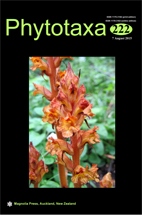Abstract
Petunia patagonica is restricted to the Patagonian region of Argentina and its identity is controversial. The species was described in the genus Nierembergia, and subsequently transferred to the genus Petunia. However, several morphological characteristics of P. patagonica as well as its geographical distribution differ from other Petunia species, and it has been repeatedly considered an exception in the genus. Using one nuclear and two cpDNA markers for 22 species representing seven genera of the tribe Petunieae, we analyzed phylogenetic and biogeographic evidence to clarify the phylogenetic position of P. patagonica. Our results suggest that P. patagonica is not a member of the genus Petunia and is closer to Fabiana imbricata. In addition, Calibrachoa appears basal within the Petunia, Calibrachoa, and Fabiana clades, and Fabiana and Petunia are sister genera. This result led us to reconstruct an ancestral region for this clade within the subtropical grasslands of South America. Subsequent dispersion to the Patagonian and Andean regions was inferred in the divergence of Fabiana and P. patagonica. Our work suggests a need for more studies towards a new generic placement. Ancestral area reconstruction suggests that the origin of the Calibrachoa, Fabiana and Petunia lineages was located in the subtropical grasslands of South America, and the colonization of the Andes and Patagonia seems to be divergent and was achieved only for species belonging to the Fabiana and P. patagonica clades.

